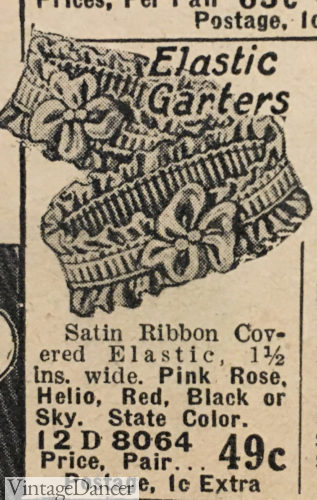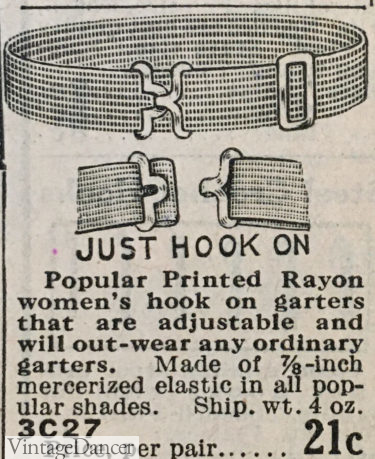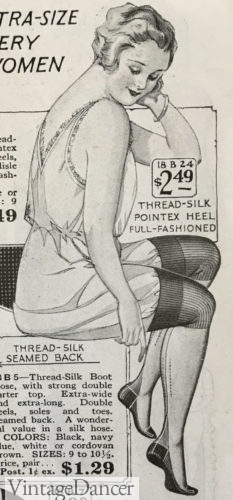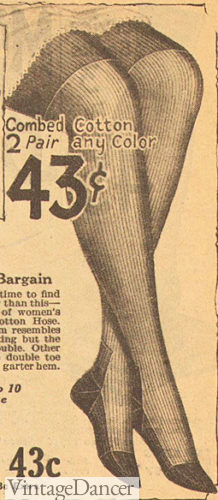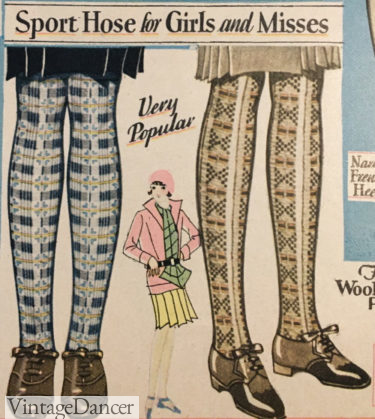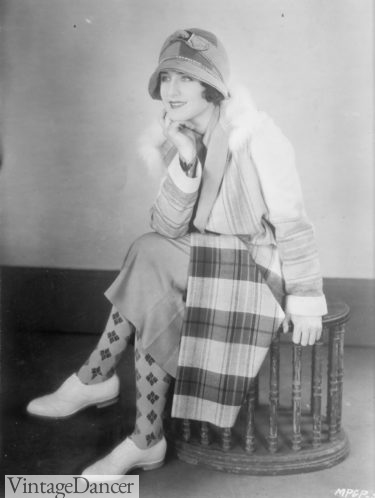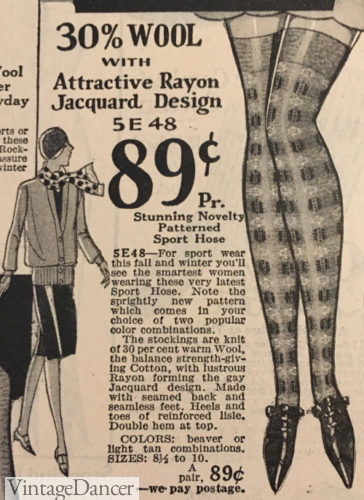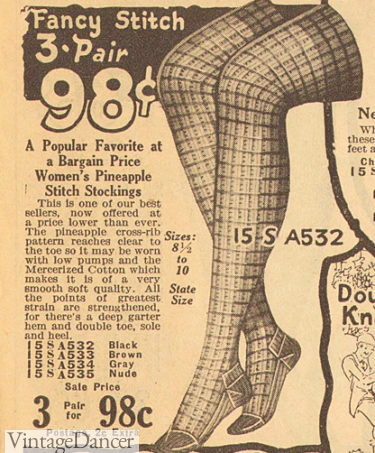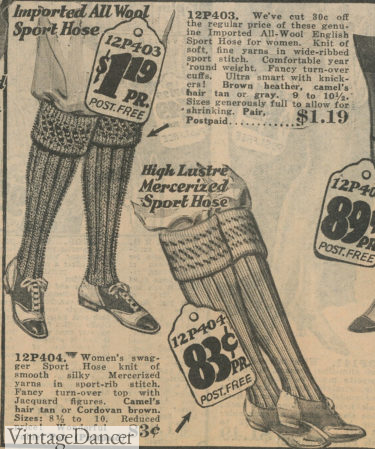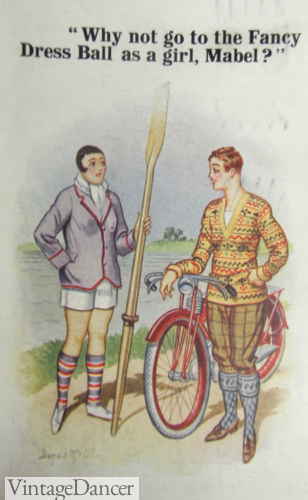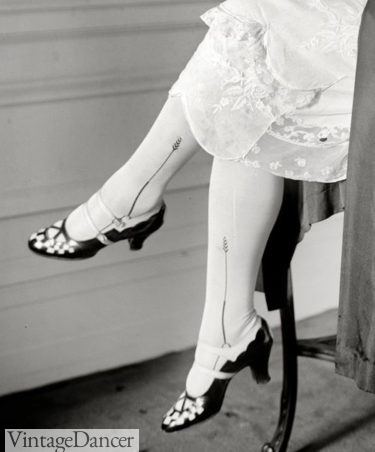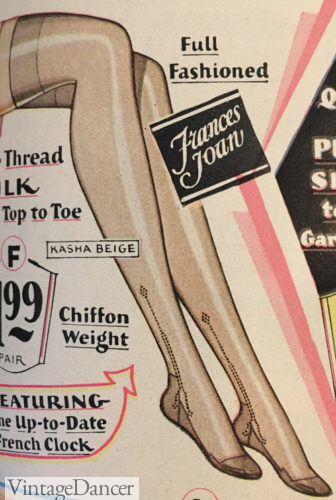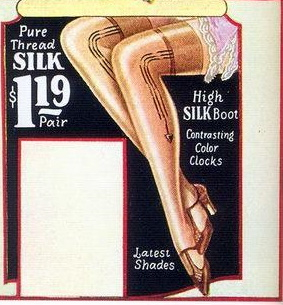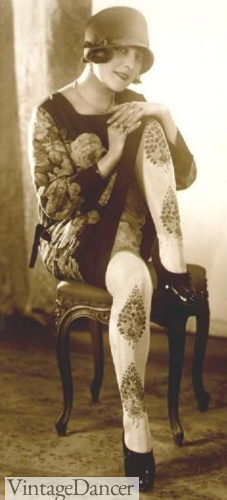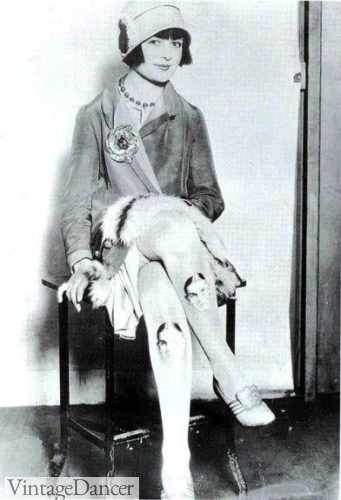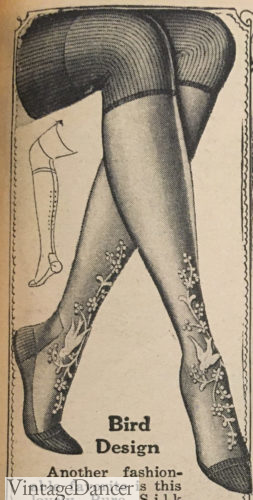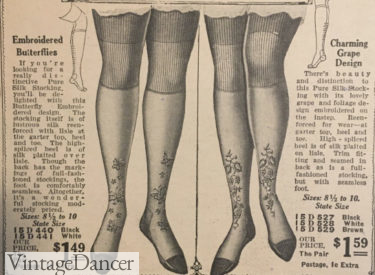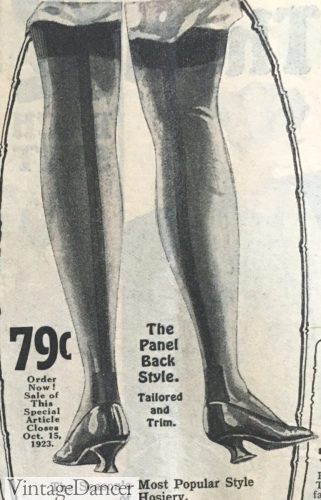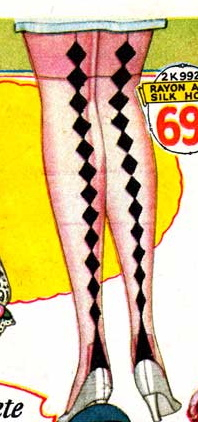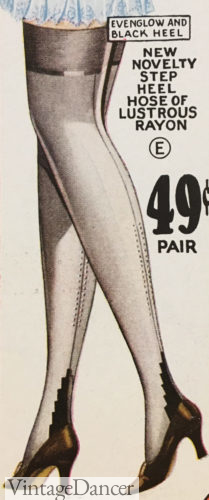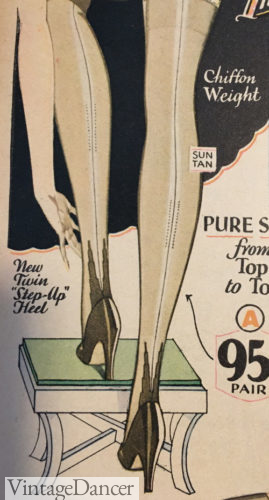Roll ’em girls roll ’em girls
Go ahead and roll ’em
Roll ’em down and show your pretty knees
Roll ’em girls roll ’em ev’rybody roll ’em
Roll ’em high or low just as you please
Don’t let people tell you that it’s shocking
Paint your sweetie’s picture
On your stocking
Laugh at ma, laugh at pa
Give them all the ha-ha
(1925, Roll’em Girls by Billy Murray, hear it sung)
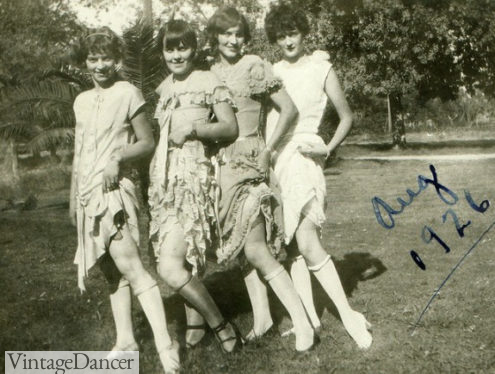
Young girls showing off their Rolled Stockings, 1926
1920s Stockings
Women’s legs had never received as much attention as they did in the 1920s. New flapper styles exposed the calves with short dresses that ranged from mid-calf to daringly just below the knee. Before the ‘20s, women wore stockings for warmth more than anything else. But once the legs could actually be seen – in public! – stockings became yet another fashion accessory in a style-obsessed decade.
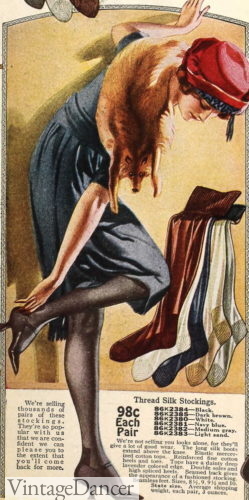
1922 silk stockings
At the time, it was simply unheard of for a woman to leave the house without some type of covering on her legs. That covering was almost always silk or rayon stockings.
Stockings of the ’20s (called nylons, pantyhose or tights today) were made from silk, wool, cotton or synthetic rayon – a new material. The rayon versions were so shiny that many women who wore them dusted powder on the stockings to make them look matte.
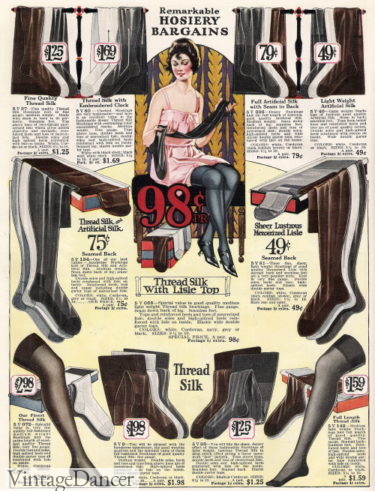
1922 silk, lisle, cotton stockings
Cotton stockings were available, but they were considered practical and not very fashionable. A mix of silk or rayon with cotton provided the best of both materials and the longest wear.
Shop for 1920s style stockings.
Rolled Stockings
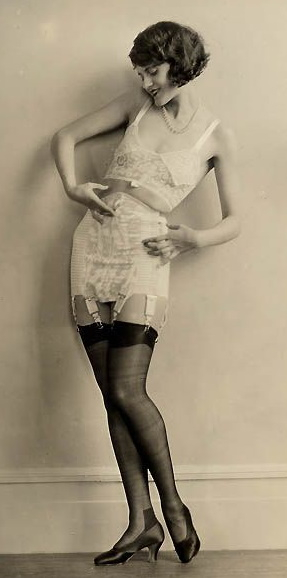
Stockings held up with garter clips attached to a girdle
Stockings came to about mid or upper thigh and had to be held up by garter clips attached to either a corset or a girdle with clips or gilt mounts. It was also common for young women who didn’t like to wear girdles to “roll” their stockings down, using a ribbon or elastic garter band to just above the knee – a trick that wasn’t easy to master. Young women were fixing their rolls several times a day.
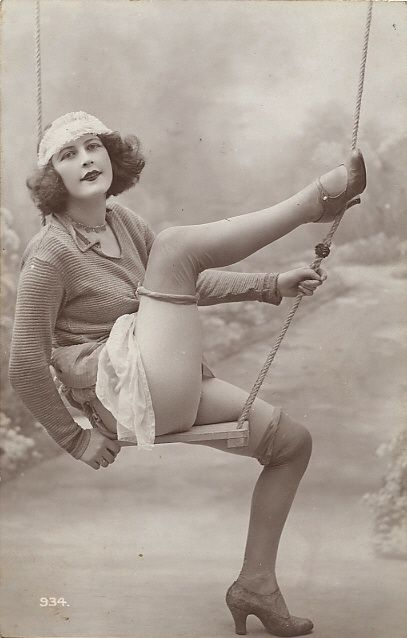
Rolled stockings could be above or below the knee. This naughty postcard girl shows off her thigh rolled stockings
Rolled stockings? Indeed! Flappers were known to roll their stockings to down below the knee, and just to make sure you noticed that their knees were bare, they applied a little rouge makeup to make their knees look rosy. Why? Because women were not supposed to be seen with bare legs, and this little glimpse of skin was such a Jazz Age kind of thing to do! There was a brief fad for girls to paint a picture of their boyfriend on their knee, or perhaps a favorite movie star.
“Check out the getaway sticks on the flapper, bub!” (1920s slang for “she has nice legs”)
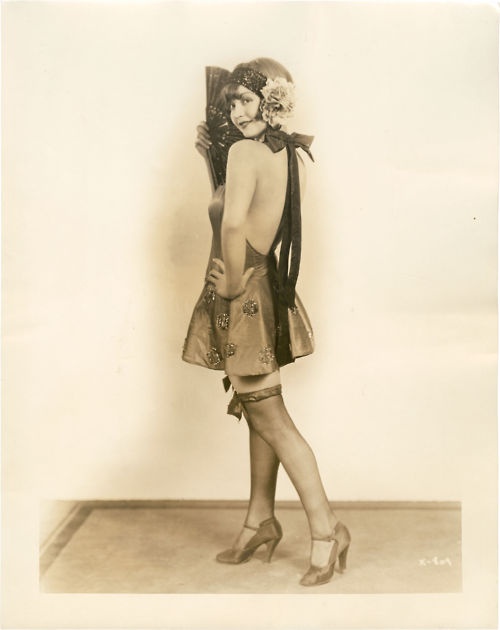
1920’s flapper in rolled stockings with ribbon garter
If you ever saw your grandmother or great-grandmother use a rubber band to hold her stockings up, she was using a makeshift roll garter. Authentic garter rolls were round and soft covered elastic bands that rolled up the leg and then back down a little, catching the top of the stocking.
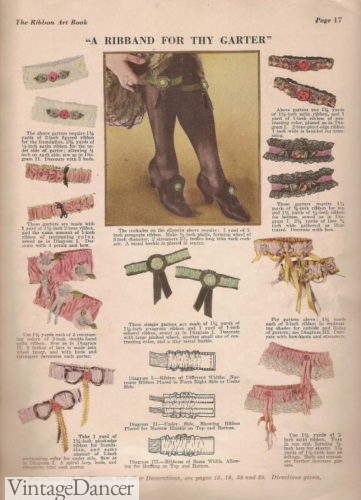
1923 ribbon garters
Garters were also made of an elastic circle with hook or a pretty ribbon covered elastic band, called a Jazz Garter. These garters were available in pink, light blue, purple, yellow, red, black or white. They didn’t need to be rolled if they fit snug enough around the thigh.
- 1925 satin ribbon covered elastic garter with flower and bow
- 1929 plain elastic garter band with hook
Fancy flappers wore a decorated gold or silver band garter (yes, made of the actual metal) worn just above the left knee, with stockings attached to garters. The bands were exposed whenever a skirt swung just enough – shocking the older generation yet again.
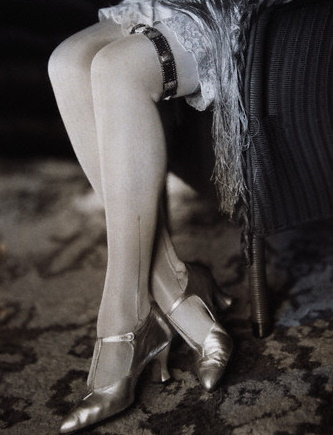
Metal garter band
The other time wearing rolled stockings was popular was at the beach. Young women who entered bathing beauty contests couldn’t wear a garter belt, so they rolled their black stockings down to below the knee. The gap left between the knee and the swimsuit skirt was scandalous — and on many beaches, illegal.
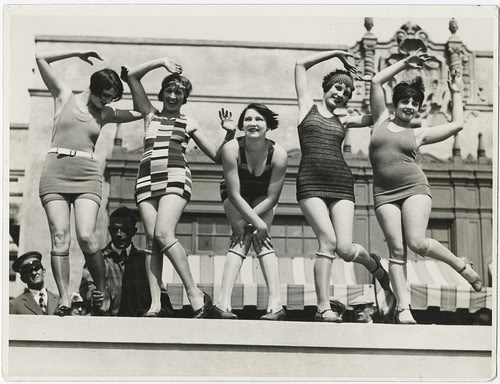
Dancing in rolled stockings swimsuits for a bathing beauty contest
Stocking Construction
There are four styles of hosiery: full-fashioned, semi-fashioned, tubular, and cut.
Full-fashioned hose are knitted flat in the silhouette of a leg, then stitched together with a seam down the back of the leg and the bottom of the foot. The ribs of the stocking run diagonally into the V-shaped intakes on each side of the big seam. They are considered the best of the stocking constructions with the least amount of bagging at the ankles.
Semi-fashioned stockings are of a circular knit. These are shaped by shrinking and pressing on a leg form. A mock seam and narrowing marks may be made in the back to resemble the full-fashioned variety.
Tubular hose are made for children; they are not shaped and do not have a seam down the back.
Cut hose are tubes stitched on a circular knitting machine, then cut the length of a leg. The foot is sewn and pressed into shape separately, then attached to the leg tube. These are the cheapest construction stockings and not very comfortable in the foot area. They also bagged at the ankle. Only the poor bought these.
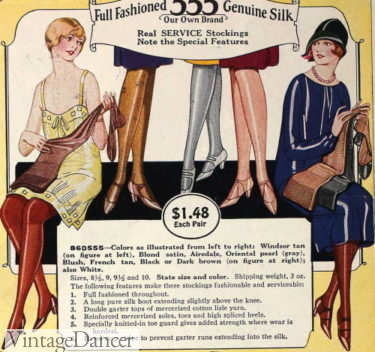
1925 fully fashioned silk stockings
The durability of hosiery depends greatly upon the weight. The ultra-sheer hose are listed as “two-thread” chiffon. This means that every thread is made of two strands of thread twisted together. These hose are very fragile and should be worn only for the evening.
Three-thread hose are listed as semi-chiffon, and are suitable for afternoon or dress occasions. Four- and five-thread hose are called semi- service. The six-thread, seven-thread, and eight-thread hose are service weight.
Semi-service or service-weight hose would be worn for school. Cotton, wool, or service-weight silk was good for sportswear.
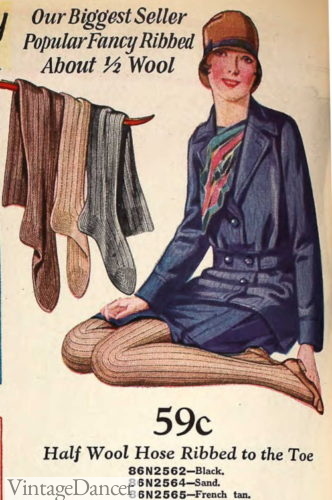
1928 ribbed wool/cotton stockings
Stockings came in sizes 8.5 to 10, which was a number that reflected the shoe size. There was little stretch to them and they tended to bag at the ankles. For stout ladies (plus sizes) “out size” stockings were offered in wide leg widths.
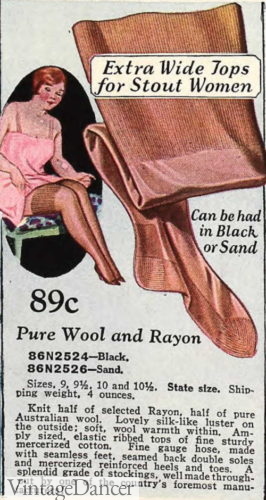
1928 “plus size” stockings
The sheerer the stockings were, the more hair was seen underneath. (Uh oh, time to shave those legs.) Shaving underarms had been in practice for several decades already, but legs were something new. Some stocking advertisers said “smooth legs and smooth stockings” go hand in hand while others said stockings do a find job of covering up unsightly leg hair. The leg shaving trend was only picked up by the most fashion forward flappers.
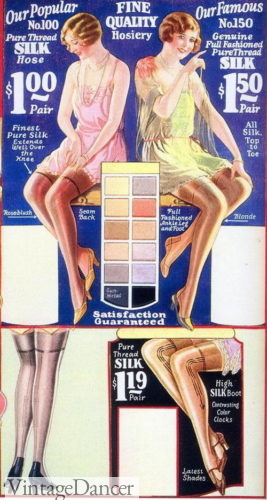
1927 silk stockings
Stocking Yarn
The quality of a stocking was reflected in the price. Women were advised to buy the most expensive stocking they could afford to ensure durability and fit. Material also had a play:
- Wool stockings there thick and a bit scratchy, but were the best for cold winter wear. Cashmere was the softest and warmest wool.
- Cotton stockings were usually combed or ribbed for durability and thickness. Quality ranged from cheap to moderate. Cotton feet and thigh bands were added to more expensive silk stockings to bring the price down and increase durability. Cotton was easy to repair in the heels and toes, where most damage occurred.
- Lisle– Was an inexpensive, sometimes mercerized (for shine), durable cotton ideal for housewear, sports, walking, and working conditions. Like wool and cotton, many were texturized in stripes, honeycomb, checks, and plaid patterns. Shiny lisle was the poor woman’s silk.
- Rayon or artificial silk had the shine of real silk and breathability of cotton, all at half the price. Rayon was usually blended with other fibers to get the best of both worlds.
- Silk was still the best- easier to wash, less baggy, less slippery (less falling down), warmer, and wasn’t quite as shiny as rayon. Sheer silk chiffon stockings were worn in the evenings, but they usually didn’t last more than 1 or 2 wears.
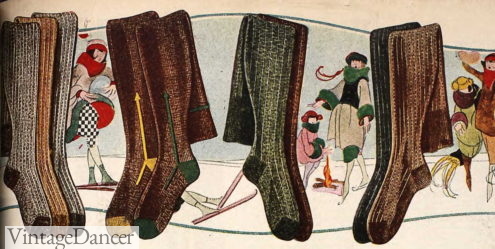
1922 heavy wool stocking for winter
- 1923 reinforced heel, toe and band stockings
- 1926 ribbed cotton stockings
Stocking Colors
Women’s stockings in the early years were plain. Black was the most common with brown, grey, navy blue, or white being options that coordinated with dresses. In winter, stockings were made of a heavy smooth or ribbed knit wool, lisle, cashmere or cotton. Silk was also an option for dressy occasions and warmer weather. Heels and toes were reinforced in cotton with the thigh band ribbed for added durability.
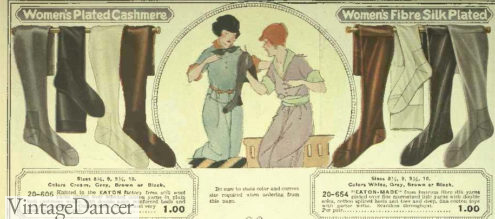
1920 cashmere and silk stockings
By the mid-1920s, colors were slowly broadening to include peach, grey-brown, and nude. Nude was a new color that was supposed to mimic a fresh sun-tanned complexion. Then came a variety of intermediate colors. Now there were 4-5 shades of brown/tan/nude and light and dark grey. Each brand had its own names and range of colors.
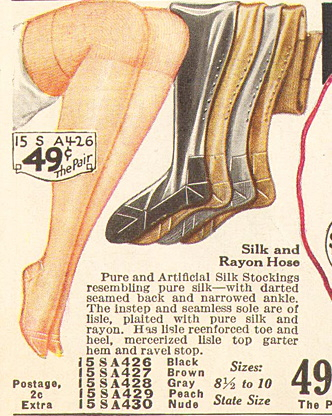
1926 stocking colors- black, brown, grey, peach, nude
What would a woman choose? In general, women wore wear a lighter stocking than her dress with lighter colors in summer, and darker ones in winter. These were not hard rules and each woman dressed to her own desire.

1927 stockings colors

1927 stockings colors
By the end to the decade, stocking colors continued to expand into new pastels: champagne, purple, cream, light green, yellow, pink, red and silver (some with real metal thread).
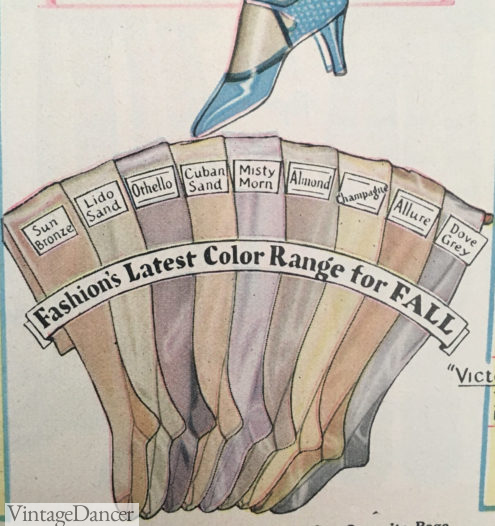
1929 stockings colors for fall: sun bronze, lido sand, Othello purple, Cuban sand, misty morn, Almond, Champagne, Allure, and dove grey.
In the evenings, women would match stockings to dresses. The sheerest knits such as silk chiffon were saved for evenings, too, because of how fragile they were.

1928 chiffon weight stockings for fancy dresses
African American women, Latinas, and other deep skin toned ladies didn’t have matching skin tone stockings to choose from. Manufacturers were not making stockings in skin shades deeper than a medium tan. Instead, women of color could choose any color of stocking they liked.
Wearing black was common for women in service professions and for day to day durability. Nude colors lightened skin tones, while grey or white made flapper’s legs stand out.
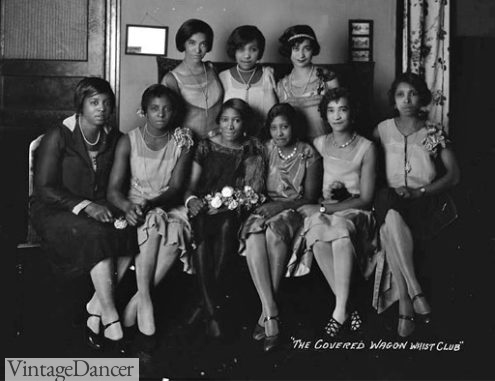
The ladies from the Covered Wagon Whist Club wore a variety of stocking colors.
Stockings were often coordinated with accessories such as a handbag, hat, gloves or dress. Notice below how the woman on the left wore white stockings to pair with the lace collar on her dress, while the woman in the middle wore black stockings with her probably navy blue or black dress. The woman on the right choose a medium tan stocking to pair with her medium tone pattern dress. These ladies are well coordinated!
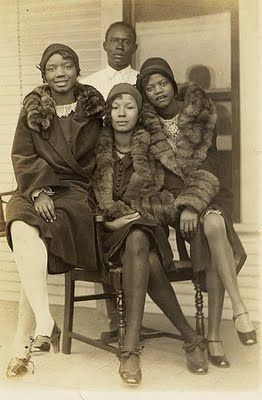
Black flappers could wear any shade they liked – black, brown or white.
Sport Stockings
While most stockings were solid colors, there were also fun, patterned stockings worn with casual “sporty” outfits. Vertical stripes, plaid, lace knits, checks, argyle, and Fair Isle – the same patterns found on casual sweaters – made an appearance in stockings as well. These stockings were fun to wear in the daytime, on weekends, and as alternatives to socks. See a genuine vintage pair of 1920s sport stockings at the Met here and here.
- 1929 check pattern stockings
- Norma Shearer wears argyle print stockings
- 1929 Jacquard pattern stockings in grey or brown
- 1926 “pineapple stitch” sport hoise
Socks had yet to catch on for daywear in the 1920s. Children wore them, men wore them, but women wore stockings. The exception was tall knee-high or over the knee socks worn with knicker pants or sport skirts. Like men’s sport socks, they were very thick and heavily patterned knits with a wide cuff at the top.
- 1924 sport socks
- Poking fun at the masculine outfits including tall sport socks
When ankle socks, then called “Footees,” were introduced around 1928, they were not meant to replace stockings but to be worn over them as an added layer of warmth and fun fashion. A few tennis players also began wearing white socks with their tennis dresses. They were so popular they started a new trend for short socks in the 1930s.
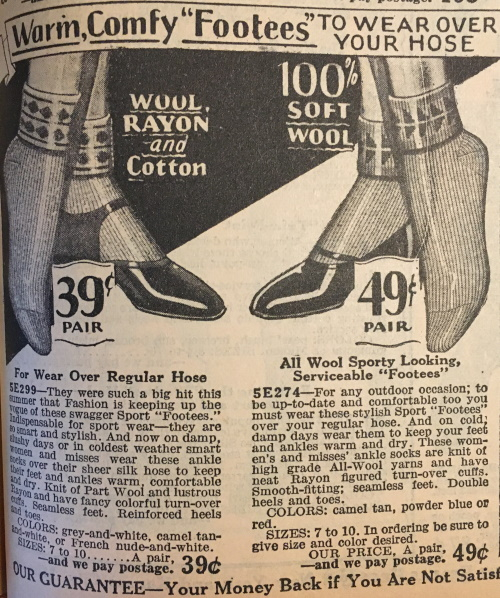
1929 ankle socks worn over stockings
Another type of knit sock was actually the knit gaiter or spats, designed to fit over shoes with a strap running under the sole. They helped keep legs warm in winter and stockings cleaner. The fun prints and weaves added personality to the wearer’s outfits, too.
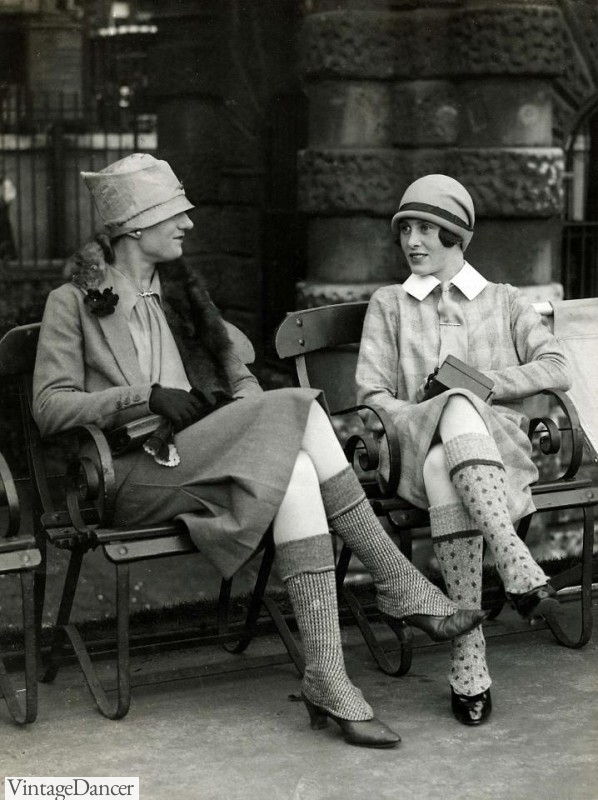
1926 Scotland: ladies wear knitted gaiters over their shoes- warm and clean!
Decorations
While most stockings were plainly colored, that did not mean they lacked decoration. Some decoration on the heels and backseams were a necessary part of the manufacturing process, while some decorations were added to the back, heels and sides for purely ornamental reasons.
In the 1920s “clock” or “clox” stockings featured embroidered vertical arrows or small patterns over the ankles and up the leg on both sides, some with lace inserts.
- 1921 clocked stockings
- 1923 clocked stockings
- 1929 clocked stockings
- 1927 thigh clocks
Embroidery was also placed on the front in the form of a cascade of flowers, animals, insects, or food. Some women handpainted Art Deco designs, Asian motifs, or even a boyfriend’s face on knees, shins, and ankles. Some stitched in feathers and sequins to add dimension.
- Peacock painted stockings
- Face painted
- 1925 Embroidered birds and leaves
- 1925 Embroidered butterfly and grape vines
Stripe stockings were a popular all-over pattern in the early to middle years. At first, it was ribbed stripes that kept legs warm and fashionable. Then came tonal, black and white or grey stockings in vertical or horizontal patterns.
They were called The Illusion Stocking because the vertical stripes made fat legs look thinner while the horizontal stripe makes skinny legs look wider. As a short person with thick legs, I can attest to the fact the vertical stripes are more flattering than horizontal stripes.
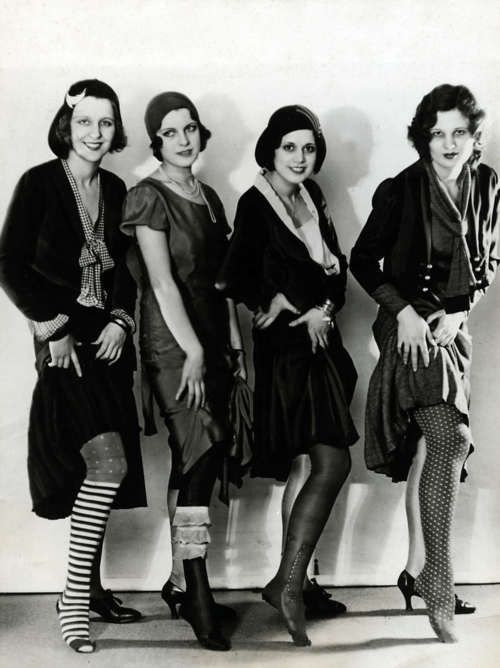
Stripes, lace ruffles, clocked and polka dot hosiery
Another all-over pattern with a brief history was the lace knit stocking. They were a breathable novelty design that was worn in the early years during summer.
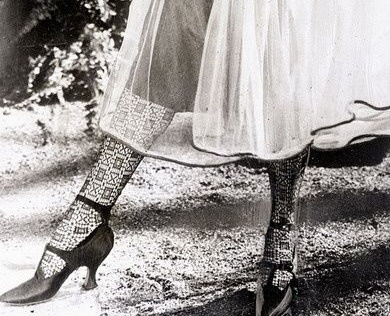
1921 lace knit stockings
What about fishnets? Supposedly, they were worn by a few showgirls and naughty flappers (I have yet to find photographic evidence of this). Fishnets were simply too revealing for most women, and they did nothing to cover up leg hair. They became associated with flappers in the 1950s-1960s revival of the 1920s, where showgirls regularly wore fishnets. They added drama to the showgirl’s dancing legs in musicals and stage shows.
The cross-ribbed pineapple stitch stockings had a similar appearance to wide fishnets. Perhaps these were the inspiration for the flapper revival?
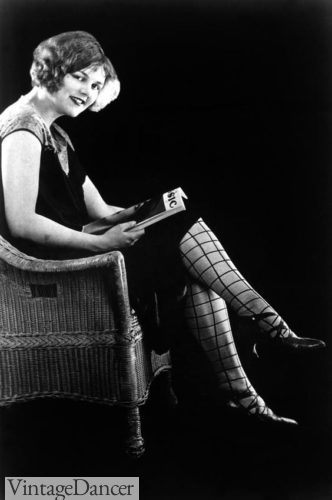
These cross-ribbed (pineapple stitch) stockings have a similar appearance to wide fishnets.
Backseams
Fully fashioned stockings had backseams as well as a column of vertical holes along the seams that were made by increasing and decreasing the stitches in the manufacturing process. Since fully Fashioned stockings were considered the best cut, women wanted to see those unmistakable backseams and pinholes. These were called “full fashion marks,” “fashioning marks,” “fashion points,” or “narrowing marks” and were signs of wealth and good taste.
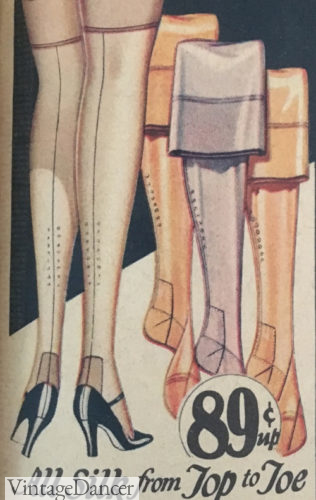
1929 fully fashion stockings with unmistakable fashion marks
Circular knit stockings stitched on backseams, while poor women may have painted on a seam. The backseam was seen as a slimming illusion for women’s leg. Most seams were very thin and in a matching thread. Backseams could also be thicker, have two stripes, or were decorated in diamonds, arrows, and other geometric designs.
- 1923 wide stripe backseam
- 1928 diamond backseam
The final thing to note about women’s stockings were the various heel styles. Heels could be simply low reinforced heels or with more decorative designs such as the wide and square Cuban heel. In the late 1920s, many more heels designs were becoming trendy such as the pointed heel (tall triangle), diamond heel (spit into two triangle towers), step up heel (like a staircase), and Paris heel (narrow and tall Cuban rectangle).
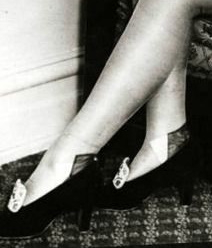
Reinforced Cuban heel stockings (no backseams)
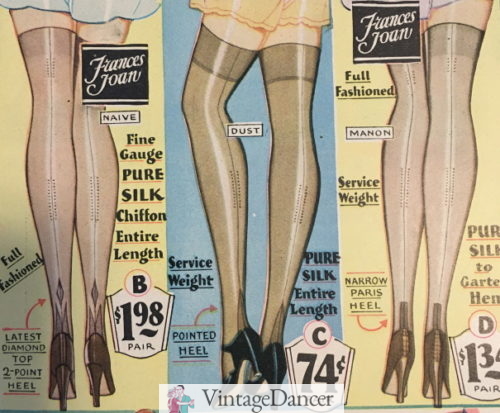
1929 diamond, pointed, and Paris heel
These heel designs appeared well above the shoe line and that was perfectly acceptable. Even the reinforced, functional, foot and heel were visible on some low cut shoes like pumps. It was a fact of the stocking and women couldn’t do much about it. Much like finding the perfect pair of comfortable shoes, women went through many brands and cuts, colors and yarns, to find the perfect stocking. Great care was taken in putting on stockings, taking them off, washing (warm water and castile soap) and mending-every night! At $1-2 dollars a pair (about $7-15 in today’s curency) they were not an inexpensive commodity.
- 1929 single step up heel
- 1929 twin step up heels
Wearing 1920s Stockings Today
When choosing stockings for your 1920s outfit, keep these tips in mind:
- Choose nudes and tans one shade darker than your natural skintone. Otherwise, choose a light colors for light dresses and dark browns, greys, or black for dark dresses.
- For working classes, look for ribbed tights in black or brown or thick tights like Ice Skating tights if you will be outside.
- Matte sheen is better than shiny materials. Choose a heavier, not sheer, thickness. Tights are usually better than nylons for daywear. Save your sheer nylons for evenings.
- Backseams are optional, but they always take an outfit up a notch. Backseams should match the hosiery. No black seams on nude stockings, colored seams, etc
- Wear one to two sizes up for a looser fit which, will look more period correct.
- Unless you want to show off rolled down stockings or your garters, you can wear full tights and pantyhose- no one will know the difference under your dress.
- Do not wear fishnets unless you are going for the naughty stage performer look. Choose a large net pattern over small patterns.
Shop for 1920s style stockings and socks here.
Debbie Sessions has been teaching fashion history and helping people dress for vintage themed events since 2009. She has turned a hobby into VintageDancer.com with hundreds of well researched articles and hand picked links to vintage inspired clothing online. She aims to make dressing accurately (or not) an affordable option for all. Oh, and she dances too.
